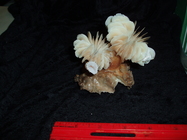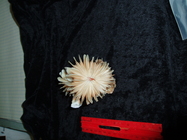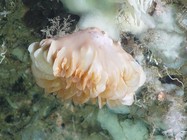| Introduction | | Species lists | | Search taxa | | Taxon tree | | Literature | | Distributions | | Statistics | | Editors | | Match taxa | | Webservice | | Log in |
WoRMS taxon detailsDesmophyllum Ehrenberg, 1834
135093 (urn:lsid:marinespecies.org:taxname:135093)
accepted
Genus
Madrepora dianthus Esper, 1794 accepted as Desmophyllum dianthus (Esper, 1794) (type by subsequent designation)
Lophelia Milne Edwards & Haime, 1849 · unaccepted > junior subjective synonym
Lophohelia Milne Edwards & Haime, 1857 · unaccepted > junior subjective synonym
Psammosmilia de Fromentel, 1866 † · unaccepted > junior subjective synonym
Pseudodesmophyllum Reig Oriol, 1997 † · unaccepted > junior subjective synonym
Scolangia Tenison-Woods, 1880 † · unaccepted > junior subjective synonym
Thalassiotrochus Milne Edwards, 1861 · unaccepted > junior subjective synonym
marine,
recent + fossil
Ehrenberg, C. G. (1834). Beiträge zur physiologischen Kenntniss der Corallenthiere im allgemeinen, und besonders des rothen Meeres, nebst einem Versuche zur physiologischen Systematik derselben. <em>Abhandlungen der Königlichen Akademie der Wissenschaften, Berlin.</em> 1: 225-380., available online at https://www.biodiversitylibrary.org/page/29725862 [details]
Depth range 8-2460 m
Depth range 8-2460 m [details] Fossil range Upper Cretaceous to Recent
Fossil range Upper Cretaceous to Recent [details]
Hoeksema, B. W.; Cairns, S. (2025). World List of Scleractinia. Desmophyllum Ehrenberg, 1834. Accessed through: World Register of Marine Species at: https://www.marinespecies.org/aphia.php?p=taxdetails&id=135093 on 2025-07-15
Date action by 2006-07-31 06:57:06Z changed Camba Reu, Cibran
Nomenclatureoriginal description
Ehrenberg, C. G. (1834). Beiträge zur physiologischen Kenntniss der Corallenthiere im allgemeinen, und besonders des rothen Meeres, nebst einem Versuche zur physiologischen Systematik derselben. <em>Abhandlungen der Königlichen Akademie der Wissenschaften, Berlin.</em> 1: 225-380., available online at https://www.biodiversitylibrary.org/page/29725862 [details] original description (of Lophelia Milne Edwards & Haime, 1849) Milne Edwards H, Haime J (1849) Mémoire sur les polypiers appartenant a aux groups naturels des zoanthaires perforés es des zoanthaires tabulés. Comptes rendus hebdomadaires des séances de l'Académie des sciences 29: 257-263. [details] original description (of Lophohelia Milne Edwards & Haime, 1857) Milne Edwards H, Haime J. (1857). Histoire naturelle des coralliaires ou polypes proprement dits 2. Librairie Encyclopédique de Roret, Paris. 631 pp., available online at https://www.biodiversitylibrary.org/page/12403706 [details] original description (of Thalassiotrochus Milne Edwards, 1861) Milne Edwards A. (1861). Observations zur l'existence de divers mollusques et zoophytes. <em>Annales des Sciences Naturelles, Zoologie, Series 4.</em> 15: 149-157. [details] original description (of Scolangia Tenison-Woods, 1880 †) Tenison Woods, J. E. (1880). Corals and Bryozoa of the Neozoic period in New Zealand. <em>Palaeontology of New Zealand. Colonial Museum and Geological Survey Department.</em> 4: i-xvi, 1-34, 3 pls. [details] original description (of Psammosmilia de Fromentel, 1866 †) Fromentel E. de. (1866). Paléontologie française ou description des Animaux invertébrés fossiles de la France. Terrain crétacé. Tome 8 : Zoophytes. p. 241-288. [details] original description (of Pseudodesmophyllum Reig Oriol, 1997 †) Reig Oriol, J. M. (1997). Generos y especies nuevas de Madreporarios cretacicos. <em>Barcelona, Self-published,.</em> 45 pp., 5 pls. [details] basis of record Cairns, S.D., Hoeksema, B.W., and J. van der Land, 2001. Scleractinia, <B><I>in</I></B>: Costello, M.J. <i>et al.</i> (Ed.) (2001). <i>European register of marine species: a check-list of the marine species in Europe and a bibliography of guides to their identification. Collection Patrimoines Naturels,</i> 50: pp. 109-110 (look up in IMIS) [details] Taxonomyredescription
Cairns, S.D. (2000). A revision of the shallow-water azooxanthellate Scleractinia of the western Atlantic. <em>Studies on the Natural History of the Caribbean Region.</em> 75: 1-231. [details] Available for editors redescription Cairns, S.D. (1995). The marine fauna of New Zealand: Scleractinia (Cnidaria: Anthozoa. <em>New Zealand Oceanographic Memoir.</em> 103: 1-210. [details] Available for editors redescription Cairns, S.D. (1994). Scleractinia of the temperate North Pacific. <em>Smithsonian Contributions to Zoology.</em> 557: 1-150. [details] Available for editors Otheradditional source
Neave, Sheffield Airey. (1939-1996). Nomenclator Zoologicus vol. 1-10 Online. <em>[Online Nomenclator Zoologicus at Checklistbank. Ubio link has gone].</em> , available online at https://www.checklistbank.org/dataset/126539/about [details]
additional source Veron JEN. (1986). Corals of Australia and the Indo-Pacific. <em>Angus & Robertson Publishers.</em> [details] additional source Randall RH. (2003). An annotated checklist of hydrozoan and scleractinian corals collected from Guam and other Mariana Islands. <em>Micronesica.</em> 35-36: 121-137. page(s): 135 [details] additional source Cairns, S.D. (2009-2017). On line appendix: Phylogenetic list of the 711 valid Recent azooxanthellate scleractinian species with their junior synonyms and depth ranges, 28 pp. <em>In: Cold-Water Corals: The Biology and Geology of Deep-Sea Coral Habitats.</em> Cambridge University Press, Cambridge. [details] additional source Cairns, S.D., L. Gershwin, F.J. Brook, P. Pugh, E.W. Dawson, O.V. Ocaña, W. Vervoort, G. Williams, J.E. Watson, D.M. Opresko, P. Schuchert, P.M. Hine, D.P. Gordon, H.I. Campbell, A.J. Wright, J.A.Sánchez & D.G. Fautin. (2009). Phylum Cnidaria: corals, medusae, hydroids, myxozoans. <em>in: Gordon, D.P. (Ed.) (2009). New Zealand inventory of biodiversity: 1. Kingdom Animalia: Radiata, Lophotrochozoa, Deuterostomia.</em> :59-101., available online at https://repository.si.edu/handle/10088/8431 [details] Available for editors additional source Cairns, S.D., R. Baron-Szabo, A.F. Budd, B. Lathuilière, E. Roniewicz, J. Stolarski & K.G. Johnson. (2010). Corallosphere. , available online at http://www.corallosphere.org [details] additional source Bassett-Smith, P.W. (1890). Report on the corals from Tizard and Macclesfield Banks, China Sea. <em>Annals and Magazine of Natural History,.</em> 6(35): 353-374, 443-458, pls. 12-14., available online at https://doi.org/10.1080/00222939008694050 page(s): 358, 367 [details] additional source Chevalier J-P. (1961). Recherches sur les Madreporaires et les formations recifales Miocenes de la Mediterranee occidentale. <em>Memoires de la Societe Geologique de France, Nouvelle Série.</em> 40(93): 1-562, pls. 1-26. [details] additional source Kitahara, M.V., J. Stolarski, S.D. Cairns, F. Benzoni, J.L. Stake & D.J. Miller. (2012). The first modern solitary Agariciidae (Anthozoa, Scleractinia) revealed by molecular and microstructural analysis. <em>Invertebrate Systematics.</em> 26 (3): 303-315., available online at https://doi.org/10.1071/is11053 page(s): 304, 311, 313 [details] Available for editors additional source Alcock AW. (1902). Report on the deep-sea Madreporaria of the Siboga-Expedition. <em>Siboga Expeditie.</em> 16a: 1-52, pls. 1-5., available online at https://doi.org/10.5962/bhl.title.11383 page(s): 28, 45, 50 [details] additional source Wells JW. (1958). Scleractinian Corals. <em>British-Australian New Zealand Antarctic Research Expedition 1929-31 Reports Series B.</em> 6(11): 257-275, pls. 1-2. page(s): 260 [details] additional source Farrow, G. E.; Durant, G. P. (1985). Carbonate-basaltic sediments from Cobb Seamount, Northeast Pacific: zonation, bioerosion and petrology. Marine Geology, 65, 73-102 page(s): 78, 91, 92 [details] additional source Stetson, T. R.; Squires, D. F.; Pratt, R. M. (1962). Coral banks occurring in deep water on the Blake Plateau. American Museum Novitates, (2114): 1-39 page(s): 34 [details] additional source Smith FGW. (1954). Gulf of Mexico Madreporaria. <em>Fisheries Bulletin of the Fish and Wildlife Service (U.S.).</em> 55, 291-295. page(s): 294 [details]  Present Present  Inaccurate Inaccurate  Introduced: alien Introduced: alien  Containing type locality Containing type locality
Nontype BMNH, geounit Chinese Exclusive Economic Zone [details]
Nontype UAZM, geounit Philippine Exclusive Economic Zone [details]
From editor or global species database
Diagnosis Corallum solitary, trochoid to subcylindrical, firmly attached; septothecate; pali absent; columella absent or rudimentary; sparse endothecal dissepiments in elongate coralla. [details]Remark Several dozen fossil species and three Recent species. See Baron-Szabo (2002), Cairns (1994) and Chevalier (1961) for discussion. D. dianthus is one of a dozen cosmopolitan coral species and perhaps the most commonly collected deep water coral species. It is also morphologically one of the simplest in construction. [details] Unreviewed
Biology azooxanthellate [details]Depth range 8-2460 m [details] Fossil range Upper Cretaceous to Recent [details] Habitat Known from seamounts and knolls [details]
To European Nucleotide Archive, ENA (Desmophyllum)
To European Nucleotide Archive, ENA (Lophelia) (from synonym Lophelia Milne Edwards & Haime, 1849) To Genbank (from synonym Lophelia Milne Edwards & Haime, 1849) To Genbank To Yale Peabody Museum of Natural History (YPM IZ 027293) (from synonym Lophelia Milne Edwards & Haime, 1849) To Yale Peabody Museum of Natural History (YPM IZ 061549) To ITIS |
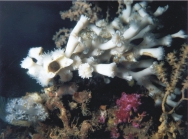

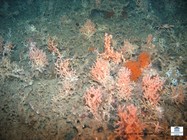
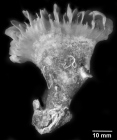
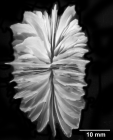
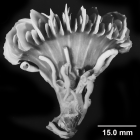
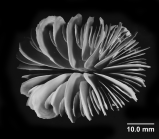

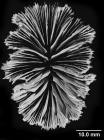

![Desmophyllum dianthus, calicular view. (Specimen identified as D. capense by Gardiner [1939]) Desmophyllum dianthus, calicular view. (Specimen identified as D. capense by Gardiner [1939])](https://images.marinespecies.org/thumbs/159307_desmophyllum-dianthus-calicular-view-specimen-identified-as-d.png?w=140)


